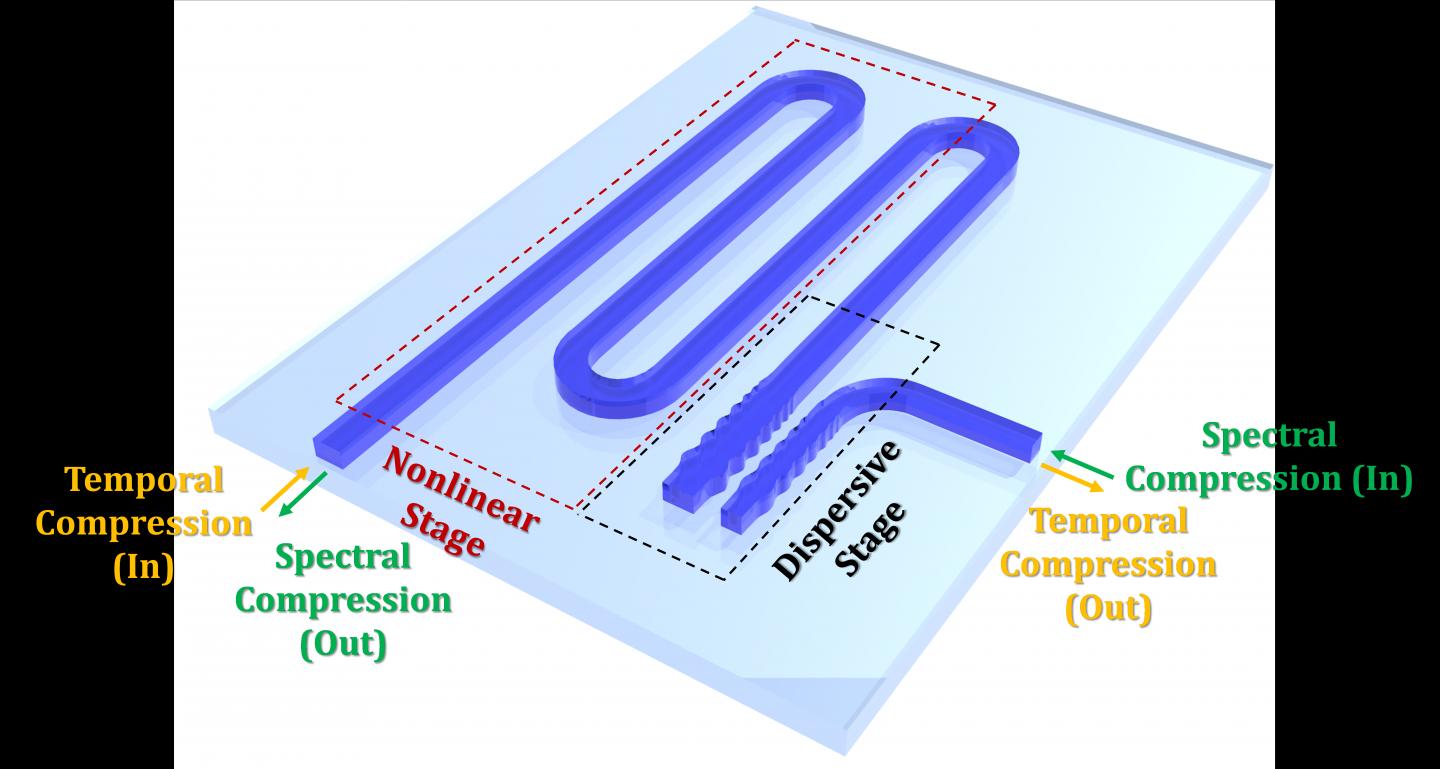SINGAPORE, July 14, 2021 — Researchers at the Singapore University of Technology and Design (SUTD), the A*STAR Institute of Microelectronics, and MIT have developed an all-optical spectrotemporal pulse compression system. The system, which is built on a CMOS-compatible ultra-silicon-rich nitride (USRN) platform, is based on an integrated design that provides direct, tailored control of a pulse’s spectral and temporal profiles. The ability to control pulse properties will allow users to efficiently leverage them for advanced metrology, high-speed optical communications, and more.
To achieve a strong rate of compression at low power, the researchers designed a device with separate nonlinear and dispersive stages integrated on one chip. Decoupling these stages allows pulses of various widths to be manipulated.

Schematic of the USRN compressor system. The system is composed of separate nonlinear and dispersive stages. For spectral compression, pulses enter the dispersive stage before entering the nonlinear stage. For temporal compression, pulses enter the nonlinear stage before entering the dispersive stage. Courtesy of SUTD.
The system has the capability to induce strong spectral compression or strong temporal compression interchangeably, depending on which input and output ports are chosen. For spectral compression, pulses enter the dispersive stage before entering the nonlinear stage; for temporal compression, pulses enter the nonlinear stage before the dispersive stage.
The researchers implemented the system on a two-photon absorption (TPA)-free, platform, which has a 500× larger nonlinear parameter than stoichiometric silicon nitride waveguides. The USRN platform enabled high field localization in a guided wave medium that allowed for low-power compression; it showed negligible TPA and extensive nonlinearity, which support efficient compression; and the platform platform preserved the pulse energy during the spectral compression process so that nonlinear frequency shifts could occur even after dispersive broadening affected the pulse.
The dispersive stage possessed linear group delay, large bandwidth, high transmissivity, and the ability to accurately engineer the magnitude of anomalous dispersion in the USRN compressor.
According to the researchers, the system is one of the highest-performing, on-chip optical pulse compressors developed to date. “By balancing the contributions from the dispersive and nonlinear stages, we could generate strong compression in either time or frequency,” SUTD research fellow Ju Won Choi said. “The temporal compression is one of the strongest demonstrated to date on a chip. The spectral compression is also the first of its kind demonstrated on a chip.”
The researchers achieved a maximum temporal compression factor of 11×, accompanied by an increase in pulse peak power by 9.4× at a low peak power of 13.3 W. They achieved a maximum on-chip spectral compression factor of 3× when compressing 480 fs pulses at a peak power of 14 W.
Strong compression on such a small device footprint could facilitate low-cost deployment of short pulses needed in telecommunications, data centers, precision manufacturing, and hyperspectral imaging.
“The demonstrated on-chip integrated system capable of both high temporal and spectral compression allows flexibility in the manipulation of optical pulses, an important capability as the burden on existing high-speed communications becomes more pronounced,” SUTD professor and principal investigator Dawn Tan said. “The data center, telecommunications, and 5G industries will require more and more capacity, and approaches such as these that help squeeze more light into a given medium will aid in this drive toward faster optical communications networks.”
The research was published in Light: Science & Applications (www.doi.org/10.1038/s41377-021-00572-z).